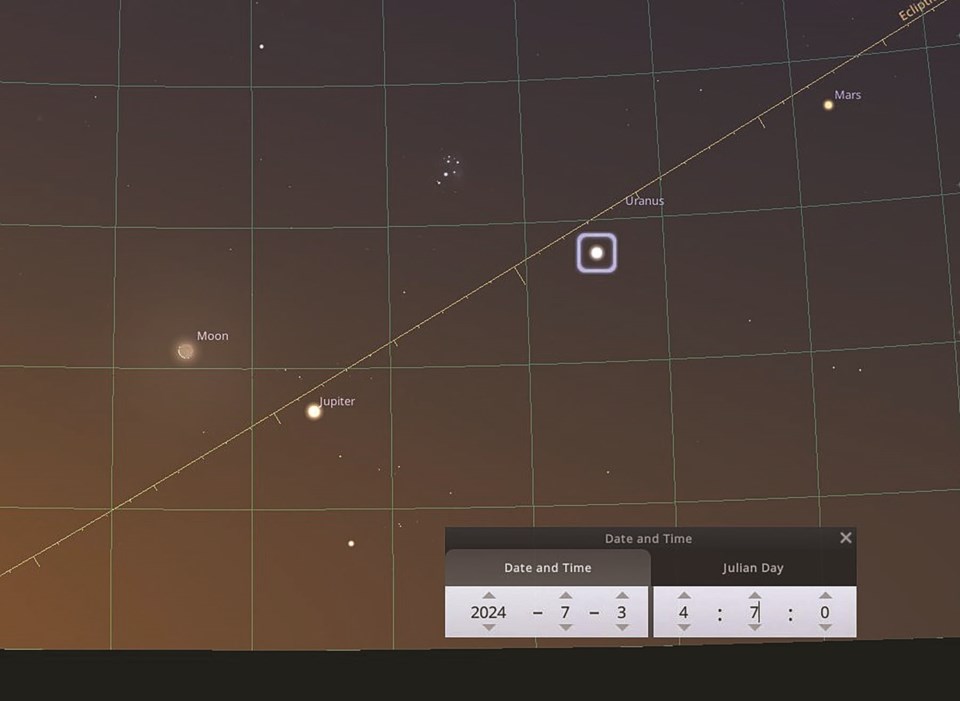Solar Cycle 25 continues to strengthen, according to SpaceWeather.com. Anyone impressed by the May auroral displays ought to be checking this site regularly; it’s run by a professional astronomer, Dr. Tony Phillips, and is pretty impressive, in my opinion. The June 25 page shows information on the second re-apparition of sunspot AR3664, which caused the show in May. (It’s renamed as AR3726 because they give them new numbers as they appear/re-appear.) The site also shows noctilucent cloud appearances, aurora predictions and even a daily update on the T Corona Borealis nova expected in the next few months.
July will be an impressive month for Space Station (ISS) enthusiasts; it begins with a couple of morning passes each day, increasing to as many as four, morning and evening, for most of the month. This happens for us during our summer when the ISS spends more time in sunlight while we’re in darkness underneath.
We’re beginning to be able to see some planets again. For the first two weeks of July from a site with nothing big to the west, like the Davis Bay pier, we should be able to see Mercury very low in the west, with the new moon going by on July 6-8. Venus is just east of the sun too but the eastern ecliptic path is tipped closer to the horizon at this time of year and it sets just after sunset.
The western ecliptic path is tipped up from the horizon, however, which makes it easy to see Jupiter and Mars before sunrise. The waning moon passes Mars and Jupiter on July 1 and 3, for example. Coincidentally, if you time it right, the ISS will be setting each morning near Mars and Jupiter from about 03:20 to 04:15 or so. Should be some cool astrophoto opportunities for those who get up that early and have a clear view to the east. The attached Stellarium screenshot shows a waning crescent moon and Jupiter just above Aldebaran, the bright star in Taurus, the Pleiades cluster above and right and Mars more right. At 04:07 the ISS sets in the east between Jupiter and Mars – all sorts of astronomy action!
Interestingly, if you continue to watch the same area over the course of July, you’ll see both Mars and Jupiter rising higher but with Jupiter moving a bit to the south and Mars staying just about straight east. That’s partly their motion but also ours; as we round the sun, we’ll catch up to Jupiter faster than to Mars. The latter then will appear closer to Jupiter as it heads in the same direction as us but more slowly.
Another good thing about July is that we can see Scorpio and Sagittarius in the south right after sunset. They’re in the direction of the centre of the Milky Way galaxy and near the southernmost portion of our ecliptic, so we only see them in the summer. The right end of Sagittarius (the Teapot asterism) is where the center of the galaxy lies with its massive black hole. We can’t see the black hole, obviously, but the Hubble telescope movie of the stars orbiting it is an eye-opener. Its mass is about four million times that of our sun and it’s smaller than the orbit of Venus. Farther west is Scorpio, which has always impressed me because it actually looks like a scorpion, if you squint a bit. The three “claw” stars on the right are Acrab, Dschubba and Fang. Seriously. First two are Arabic names, last one’s Chinese; go figure. The bright star left of them is Antares, the “rival of Mars,” which gets passed regularly by Mars as it moves a few degrees above Antares along the ecliptic. Both are reddish and roughly similar magnitude. From Sechelt at midsummer, you can see just above the southern horizon the star Shaula, the “stinger” in the scorpion’s tail.
From these two constellations you can follow the Milky Way back overhead through Cygnus to Cassiopeia and the northern horizon and the nights are warm enough to stay out for hours. While doing so, keep watching for a second bright star in Corona Borealis and you’ll have something to tell your great-grandchildren about.
The SCAC monthly meetings will resume in September and will likely be held at the Sechelt Seniors Activity Centre, depending on repair progress at the Sechelt Library. Details for the next meeting and ongoing observatory openings will be available on the club website at: sunshinecoastastronomy.wordpress.com/.



